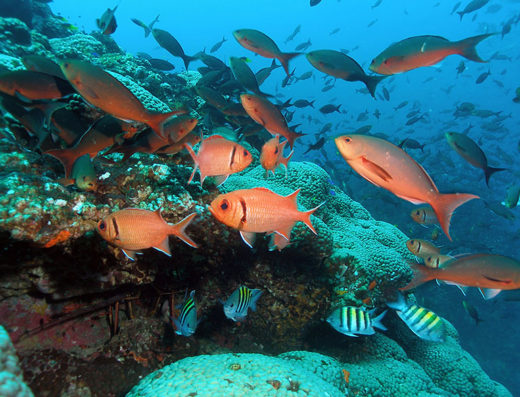Sea Life Central
Located 70 to 115 miles off the coast of Texas and Louisiana, Flower Garden Banks National Marine Sanctuary is one of 14 marine protected areas managed by NOAA’s Office of National Marine Sanctuaries.
In the warm, subtropical waters of the Gulf of Mexico, roughly 100 miles south of the Texas-Louisiana border, there lies a secret garden. East and West Flower Garden Banks, and nearby Stetson Bank, are unique underwater features festooned with colorful sponges, textured sea plants, and myriad marine life living among more than 20 species of hard corals. Arising some 450 feet from the depths of the Gulf are underwater mountains called salt domes, upon which the banks’ reef communities reside in waters from 55 to 130 feet deep.
NOAA’s Flower Garden Banks National Marine Sanctuary protects these special marine areas, each of which has its own set of boundaries. Discovered at the turn of the 20th century by fishermen in search of snapper and grouper, the banks’ colorful reefs are the northernmost in the continental United States. The closest tropical reefs lie 400 miles away, off the coast of Tampico, just north of Veracruz, Mexico.
Marine species observed in the sanctuary include graceful manta rays, gentle sea turtles, agile hammerheads, and gargantuan whale sharks — not to mention the boulder-sized brain and star corals for which the Flower Garden Banks are famous. Due to its more northerly location and lower average temperature than that of Flower Gardens, Stetson Bank is home to smaller coral colonies and dense arrays of large and vivid sponges.
Visiting Your Sanctuary
While it may not be easy to reach the Sanctuary — you’ll have to travel by boat — the rewards are great for intrepid travelers who wish to experience the wonders of its pristine offshore reefs. Several commercial diving and fishingcharter operators take people out to the sanctuary and to nearby oil and gas platforms.
Once you’ve brushed up on proper reef etiquette, you can:
Dive. The Sanctuary offers several intermediate to advanced dive sites. Weather, wave heights, and currents are unpredictable, so the area is not recommended for inexperienced divers. Find out more about the challenges of diving in the Sanctuary.
Fish. While recreational fishing is allowed in the Sanctuary, the Food and Drug Administration issued a fishing caution in 2008 warning that certain species may contain ciguatera toxin, which can be harmful if ingested by people. Catch-and-release is encouraged.
Share your observations. Visitors’ trip reports help NOAA protect the banks’ resources. Download forms from the Document Library, and be sure to include your photos and videos.
Take a Virtual Tour: Landlubbers (and those who can’t swing the trip offshore) can take virtual tours by visiting a nearby zoo or aquarium with a sanctuary exhibit, and by watching the Sanctuary Video Series. Families can also participate in Ocean Discovery Day, the sanctuary’s annual public event that takes place in March.
Photo Courtesy of National Ocean Service, NOAA, U.S. Dept. of Commerce

